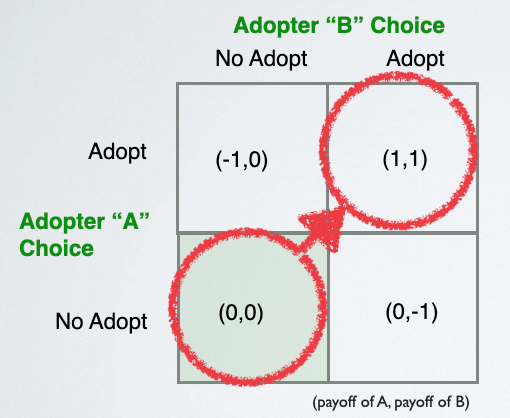Platforms can promote early adoption by shaping market expectations
This blog is written by Kevin Boudreau.
Online platforms have become an integral part of society and are used for a wide range of activities. To continue expanding and innovating in this area, successful launches of new platform ventures are crucial. However, most platform ventures fail to take off due to the chicken-and-egg problem – potential users are hesitant to adopt platforms that do not have a large installed base and network effects. This study empirically tested one way that theorists have long conjectured was a way to induce adoption: by marketing in a way that seeks to shape would-be adopters expectations of future platform success. The logic here is that if (at least some) consumers believe the platform will eventually take off, they will join, thereby catalyzing network effects. A field experiment was conducted to test the theory that the initial growth of a platform depends on the market’s subjective expectations of the size of the future installed base.

Chicken-and-Egg–and the Problem of Multiple Market Equilibria
(And, why is marketing a far more strategic challenge in platform industries?)
Before explaining the role of expectations, it is useful to precisely understand the nature of the chicken-and-egg problem that new platforms must overcome. Better understanding this question clarifies why the job of marketing and promoting a platform involves far more than just the traditional marketer’s job of creating awareness and extolling the benefits of a new offer.
Let’s use a simple example to explain this idea. Imagine a market with only two potential buyers, A and B, who are considering adopting a new platform. The idea extends to cases of larger markets, but let’s just consider two possible buyers to explain the crux of the idea.
For simplicity, consider the costs of adopting the platform is $1. This might include whatever purchase or access charges to get onto the platform, the hassle of learning how to use a new platform, and whatever other financial or non-financial costs.
If there are network effects, the benefits of adopting the platform depend on how many people also adopt it. For simplicity, let us suppose that if everyone adopts the platform, both A and B will enjoy benefits worth $2 (and the net benefit is $2, minus the cost of $1). If no one adopts the platform, there will be zero benefits (and the net benefit of adopting is zero, less the cost of $1). Thus, this simple set up illustrates a simple illustrate of payoffs from adopting a platform where value comes from network benefits (rather than “stand-alone” benefits, which do not depend on whether others join).
We can represent the possible outcomes in a table. The rows represent A’s decision (to adopt or not), and the columns represent B’s decision. The numbers in each cell represent the payoffs (or benefits) that A and B receive, respectively. This game payoff matrix shows that there are two possible stable outcomes, or equilibria in this market. In the “everybody adopts” equilibrium in the top right quadrant, both A and B adopt the platform; in the “nobody adopts” equilibrium in the bottom left quadrant, no-one adopts.

Therefore, the challenge for executives, marketers, and strategists in platform industries is that moving from non-adoption to adoption is more than just “marketing” in the traditional sense of building awareness and convincing individuals of the value of an offer. Here, successfully marketing and promoting adoption of the platform means coordinating market actors—as a group—out of the stable and self-reinforcing “nobody adopts” equilibrium to establish an altogether new equilibrium of “everybody adopts.” But, of course, no one wants to adopt the platform here and find out they are the only one.
While this abstract example is in a market of just two people, the same idea applies to real markets for platforms, with many more potential adopters or even multiple types of adopters, where some minimum critical mass must be coordinated onto a platform to successfully built a network and network value.
Coordinating the Market to Adopt – by Influencing Subjective Expectations
Coordinating a large number of adopters onto a new platform is typically extremely difficult and, in most cases, fails. One theorized strategy for promoting adoption that has been hypothesized by economists as a means of solving the chicken-and-egg adoption problem is to somehow influence consumers’ expectations that others will eventually adopt the platform.
Can this strategy work? How? The multiplicity of possible equilibria creates fundamental uncertainty about what others will do and which outcome will eventually emerge. Accordingly, adopters cannot “look forward and reason back” as in usual rational expectations, and expectations about future adoption are necessarily subjective. Therefore, conventional means of influencing rational expectations, such as economic signaling and pre-commitments, should not work as usual.
So, if expectations can be formed and influenced, how can this possibly work? If it simply isn’t possible for consumers to objectively form a rational expectations that the platform will eventually be widely adopted – can they at least form subjective expectations that a platform will be adopted? Moreover, is it even possible for executives and marketers of a platform to influence expectations themselves, given consumers should see platform executives and managers as biased storytellers about the future of their own platform?
A Field Experiment
It is exceedingly difficult to design research studies to systematically empirically study platforms. This is especially so in attempting to explicitly test how nuanced growth dynamics might be influenced by something unobservable as subjective expectations. The question of empirically testing expectations in platform industries was, in fact, an idea I had even back in graduate school at MIT, when I was thinking about the strategies I saw platform executives pursue. It took me some years to imagine a research design that would be appropriate for testing these questions, and more time to then implement the research in a live platform.
A research design was devised and implemented with the goal of investigating how statements issued from a platform about its own expectations of future size of its installed base of users affected the likelihood of individual’s adopting the platform. The experiment was conducted by randomly varying messages to 16,349 individuals identified as potential adopters of a newly launched product development platform focused on the Internet of Things (IoT). The experiment varied the content of the invitation, which included a statement regarding the number of users and companies that the platform expected would join. The invitation also included a statement about the current installed base, to disambiguate effects of statements regarding expectations from the true installed base. A central challenge of this research design was to create random variation in both statements of expected installed base and current installed base across individuals, while avoiding any deception whatsoever. (Details are explained within the paper.) The research was carried out as part of the first 60 business days following the launch.
Findings
The experiment found evidence consistent with adoption patterns being significantly affected by statements made by the platform, and overcoming the initial “chicken-and-egg” problem. Remarkably, the subjective statements regarding expectations of the future installed base had a larger influence on adoption rates than did disclosures of the true current installed base—at least this was true during early adoption. For example, statements of larger numbers of expected users caused more adoption than smaller numbers. Further, stating a small (current or expected) installed base of users led to lower demand than stating nothing at all. Statements of expectations had no effect on adoption once the installed base grew large.
Implications for Promotion, Marketing, and “Evangelism” of New Platform Ventures
The findings have important implications for the promotion, marketing, and “evangelism” of new platform ventures. The results suggest that the promotion of a new platform should focus on the potential size of the future installed base rather than the current size. Small current or expected installed bases of users should not be disclosed, as it can lead to lower demand than stating nothing at all. Instead, the focus should be on generating expectations of a large future installed base. This is particularly relevant for new platforms, which face the chicken-and-egg problem, as the expectations of the market can lead to a self-fulfilling prophecy.
The demonstration that adoption patterns can be significantly affected in a context of fundamental entrepreneurial uncertainty raises important questions. Better understanding of how and why platform entrepreneurs are able to persuade and influence market participants could bring fundamental advances to the ability to market and promote the growth of platforms. In the paper, I discuss alternative plausible explanations of why statements by the platform could have had an influence. The explanation that is most consistent with the facts is that (some) boundedly rational adopters respond to statements by the platform simply at face value, influenced by some plausible characterization or storyline of the future. In such an explanation, the adopters might even believe themselves to be prescient, as their expectations were self-fulfilling. (In this case, the eventual adoption of thousands and thousands of users in continents around the world turned out to be consistent with claimed expectations.)
If this explanation is true, adopters might not require a fully rational and credible basis for accepting statements and we might imagine some considerable role to be played by rhetoric, charisma, moral suasion, and other tools of influence. Certainly the world of platforms and tech have had persuasive storytellers and persuaders, including the likes of Steve Jobs. The last time I checked there were 2,330 “Chief Evangelists” listed on LinkedIn.
This blog is based on Kevin’s research published in Management Science, which is included in the Platform Papers references dashboard:
Boudreau, K. J. (2021). Promoting Platform Takeoff and Self-Fulfilling Expectations: Field Experimental Evidence. Management Science, 67(9), 5953-5967.